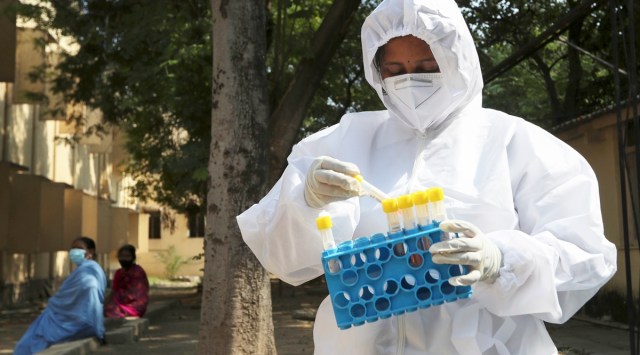Stay updated with the latest - Click here to follow us on Instagram
Covid-19: What we do and don’t know about BA.2 sub-variant of Omicron
The BA.2 lineage of the Omicron variant has been steadily increasing in many countries, including India, China and Pakistan.
 A health worker checks swab samples collected for RTPCR test to detect COVID-19 at a government hospital. (File/AP)
A health worker checks swab samples collected for RTPCR test to detect COVID-19 at a government hospital. (File/AP)As the Omicron variant of Covid-19 eases its grip on countries around the world, a sub-variant of the same is causing concern among health experts, especially in South-East Asia.
The BA.2 lineage of the Omicron variant has been steadily increasing in many countries, including India, China and Pakistan, according to the latest World Health Organisation report.
In the weekly Covid-19 epidemiological update issued on February 15, the WHO said that the overall number of new Covid-19 cases has decreased by 19 per cent as compared to the previous week. However, while the Delta variant is declining, the prevalence of BA.2 lineage among sequenced Omicron cases globally submitted to GISAID has increased to 21.09 per cent.
Here’s what we know about BA.2 sub-variant so far:
The Omicron variant comprises numerous lineages, of which — B.1.1.529, BA.1, BA.2 and BA.3 — are under WHO’s watch. The BA.2 sub-variant shares many mutations with BA.1, but it also has a number of differences, including in the spike protein, according to the WHO.
Virologist Dr Nicksy Gumede-Moeletsi said that BA.2 was proving difficult to identify as it was not always picked up by the S-gene Target Failure criterion, which is used to distinguish the original Omicron from other variants. However, the WHO said that existing Covid-19 tests like PCR, antigen and antibody tests remain as effective for BA.2 as for others.
The public virus tracking database GISAID has noted that currently, BA.1 accounts for the majority of the world’s Omicron cases. However, the prevalence of BA.2 appears to be increasing both in countries experiencing a decline in Omicron cases.
As per the latest WHO report, India, China, Pakistan, Bangladesh, Denmark, Nepal, Brunei Darussalam, Guam, Montenegro, and Philippines have reported a predominance of BA.2. South Africa, the UK, Denmark and USA too have seen an increase in the prevalence of BA.2.
That said, nations in the South-East Asian region have reported 44.7 per cent prevalence of BA.2 among Omicron sequences, while the Americas has reported around 1 per cent.
Is it more transmissible?
Early evidence suggests that BA.2 is more transmissible as compared to BA.1.
“It is currently unclear what factors drive the growth advantage of BA.2 over BA.1. Preliminary data [from Denmark and the UK] show similar antibody responses to BA.1 and BA.2,” said WHO.
A recent lab study, which is yet to be peer-reviewed, also suggested that the BA.2 subvariant of the Omicron coronavirus variant may possess certain features that not only make it more transmissible but also more capable of causing severe disease.
However, the WHO has not endorsed this. At present, there is limited evidence on the severity of BA.2 relative to BA.1 or other Omicron lineages, it said.
Do the vaccines work?
Overall, yes. Initial studies have noted that vaccine effectiveness remains the same against symptomatic disease between BA.1 and BA.2. As per the preliminary results of a study in Denmark, vaccination is at least equally effective in preventing the catching of BA.2 infection and could be more effective in preventing transmission of BA.2 compared to the currently prevalent BA.1.
The efficacy of treatment options, too, remains the same as for the existing variants.


- 017 hours ago
- 0216 hours ago
- 035 hours ago
- 047 hours ago
- 0516 hours ago





























